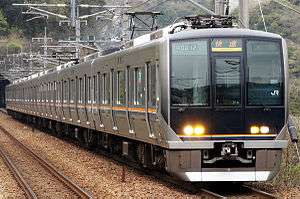321 series
The 321 series (321系, 321-kei) is a DC electric multiple unit (EMU) commuter train type operated by West Japan Railway Company (JR-West) in the Kansai Region of Japan.
| 321 series | |
|---|---|
 A 321 series train in April 2011 | |
| Manufacturer | Kinki Sharyo |
| Built at | Higashiōsaka |
| Replaced | 201 series, 205 series, 207 series (set Z16) |
| Constructed | 2005–2007 |
| Entered service | December 2005 |
| Number built | 273 vehicles (39 sets) |
| Formation | 7 cars per trainset |
| Fleet numbers | D1–D39 |
| Operator(s) | JR-West |
| Depot(s) | Aboshi |
| Line(s) served | Tōkaidō Main Line, Sanyō Main Line, Kosei Line, Fukuchiyama Line, JR Tōzai Line, Katamachi Line, Osaka Higashi Line, Yamatoji Line |
| Specifications | |
| Car body construction | Stainless steel |
| Train length | 136,600 mm (448 ft 2 in) |
| Car length | 19,550 mm (64 ft 2 in) (end cars) 19,500 mm (64 ft 0 in) (intermediate cars) |
| Width | 2,950 mm (9 ft 8 in) |
| Height | 3,630 mm (11 ft 11 in) |
| Doors | 4 pairs per side |
| Maximum speed | 120 km/h (75 mph) |
| Weight | 232.8 t |
| Traction system | Variable frequency (2-level IGBT) |
| Power output | 270 kW |
| Acceleration | 2.5 km/h/s |
| Deceleration | 4.2 km/h/s (emergency) |
| Electric system(s) | 1,500 V DC overhead |
| Current collection method | WPS27D scissors-type pantograph |
| Bogies | WDT63 (powered), WTR246/WTR246A (trailer) |
| Braking system(s) | Regenerative brake, electronically controlled pneumatic brakes, snow-resistant brake |
| Safety system(s) | ATS-SW, ATS-P |
| Track gauge | 1,067 mm (3 ft 6 in) |
Overview
The 321 series was developed from the earlier 207 series to replace the ageing 201 series and 205 series trains on the Tōkaidō Main Line. One 321 series set also replaced the 207 series (set Z16) withdrawn due to collision damage sustained in the Amagasaki rail crash of 25 April 2005.
Operations
- Tōkaidō Main Line and Sanyō Main Line: Yasu – Kakogawa
- Fukuchiyama Line: Osaka – Sasayamaguchi
- JR Tōzai Line and Katamachi Line: Amagasaki – Kizu
- Osaka Higashi Line and Kansai Main Line (Yamatoji Line): Kizu – Nara, Nara – Kyūhōji – Hanaten
Formation
| Car No. | 1 | 2 | 3 | 4 | 5 | 6 | 7 |
|---|---|---|---|---|---|---|---|
| Designation | M'c | M | T | M' | M | M' | Mc |
| Numbering | KuMoHa 320 | MoHa 321 | SaHa 321 | MoHa 320 | MoHa 321 | MoHa 320 | KuMoHa 321 |
| Capacity | 142 | 156 | 156 | 156 | 156 | 156 | 142 |
| Weight | 35.1 t | 34.1 t | 27.3 t | 33.3 t | 34.1 t | 33.3 t | 35.6 t |
KuMoHa321 and MoHa321 cars each have two scissors-type pantographs.
Interior
 Original interior style in June 2010
Original interior style in June 2010 Interior following changes to seat covers and hanging straps, November 2013
Interior following changes to seat covers and hanging straps, November 2013.jpg) LCD passenger information display
LCD passenger information display
gollark: Oh cool, the new test suite uses my "great" C wrapper.
gollark: It doesn't seem like ubq will make the container contain multiple submissions at once.
gollark: Or brute-force all possible permutations and see if the other string is one of them (case/space-insensitive).
gollark: Oh, or work out the minimal sequence of transpositions to give you the other string and see if it, well, exists or not?
gollark: Maybe throw in some linear algebra somehow to accurse it.
References
- JR全車両ハンドブック2006 (JR Rolling Stock Handbook 2006). Japan: Neko Publishing. 2006.
- JR電車編成表 '07冬号 (JR EMU Formations - Winter 2007). Japan: JRR. December 2006. ISBN 978-4-88283-046-7.
External links
| Wikimedia Commons has media related to 321 series. |
- Kinki Sharyo information (in Japanese)
This article is issued from Wikipedia. The text is licensed under Creative Commons - Attribution - Sharealike. Additional terms may apply for the media files.